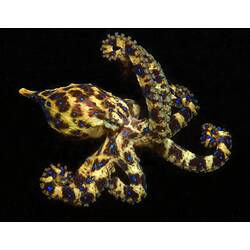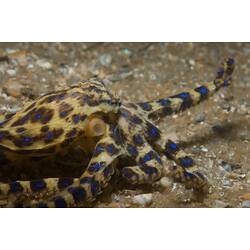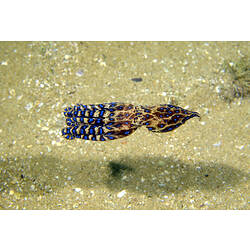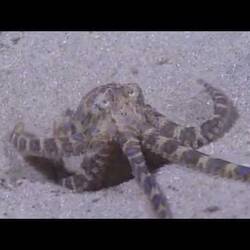General Description
Small muscular, short-armed octopus. Brown-grey at rest. Repeated colour pattern of brilliant iridescent blue rings over the body, head, arms and webs when agitated. Body oval in shape often with an extended pointed tip at the rear. Capable of excellent camouflage, hiding the blue markings and pushing up small bumps and spikes on the head and mantle. Mantle length to 6 cm, total length to around 22 cm.
Biology
This small octopus forages mainly at night feeding largely on crustaceans, particularly crabs. As in all blue-ringed octopuses, this species has large salivary glands that produce very strong toxins. The toxins are used to quickly paralyse their prey but also act as a good defence against attackers. The brilliant blue displays warn potential predators to keep away. This species of blue-ringed octopus has lost the ability to produce ink. It is possible that the strong toxins are enough to protect this octopus. Other members of the group can still produce ink. Mating occurs by males approaching females and climbing on to their bodies. The male inserts his third right arm into the female's gill cavity and passes sperm packets into her oviducts. The female lays large eggs in strings and carries them with her in her webs. The large young hatch with full colour patterns and immediately settle to the seafloor.
Distribution
Southern Australia.
Habitat
Rocky reefs, rubble areas and seagrass meadows, from the intertidal to a depth of at least 50 m.
More Information
-
Animal Type
-
Animal SubType
-
Brief Id
8 short arms, blue-rings or mottled pattern for camouflage.
-
Colours
Yellow, Blue, Brown
-
Habitats
-
Diet
Carnivore
-
Diet Categories
Crustaceans
-
Hazards
Direct threat to humans. Saliva contains the potentially lethal neurotoxin tetrodotoxin.
-
Endemicity
-
Commercial
No
-
Conservation Statuses
CITES: Not listed, FFG Threatened List: Not listed, DSE Advisory List: Not listed, IUCN Red List: Least Concern
-
Depths
Shore (0-1 m), Shallow (1-30 m)
-
Water Column Locations
On or near seafloor
-
Taxon Name
-
Scientific Author
(Hoyle, 1883)
-
Common Name
Southern Blue-ringed Octopus
-
Other Names
Blue-ring Octopus , Lesser Blue-ringed Octopus
-
Phylum
-
Class
-
Subclass
-
Order
-
Suborder
-
Family
-
Genus
-
Species Name
maculosa








